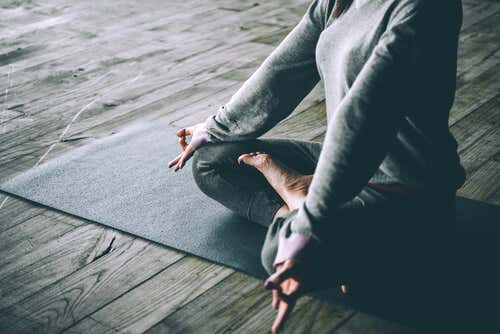Eastern practices such as yoga are becoming increasingly important. Every day, more people worldwide are joining these types of disciplines. They have proven to greatly contribute to physical and emotional health, which is why they continue to gain followers. However, many people wonder how to practice yoga at home, since they do not have the time or flexibility necessary to do it in other spaces.
It’s all about getting organized and planning the activity properly. Practicing yoga at home is an excellent idea because you can schedule your own time according to your availability. You also save money on classes and avoid trips that are sometimes uncomfortable.
“ Yoga does not remove us from reality or the responsibilities of daily life, but rather places our feet firmly and resolutely on the practical ground of experience. We do not transcend our lives; we return to the lives we have left behind in the hope of something better .”
-Donna Farhi-
Everyone should adjust their yoga practice at home in the way that they consider most convenient. However, some tips serve as a guide to organize everything, so that the sessions are as complete as possible. These are the aspects that you should take into account.
1. Create a comfortable space to do yoga at home
Find a comfortable and quiet place where you won’t be interrupted. You must find the space comfortable, as this is one of the aspects that makes practicing yoga at home easier. You will need a yoga mat and loose clothing.

It is best to allocate a specific time for each session. This helps to create a greater disposition towards the activity. In addition, it is essential that you connect with your deep conscience and set the intention of practicing yoga at home. It is not possible to do it profitably if you do not do it from the heart.
2. Define the characteristics of the practice
There are no formulas in yoga. Everything must be adapted to each person, and even to each session. Likewise, there are levels and each person must be aware of the degree of evolution they have reached in their practice. Therefore, you must design and schedule each session yourself.
In any case, it is advisable to maintain full attention during the practice and to constantly listen to what your body is saying. The session should be enjoyable. It is not advisable to do it out of commitment. That said, it is advisable that when you are a beginner you do not assume each posture for more than 30 seconds. And it may be more effective to start with half-hour sessions.
3. Keep track
To perfect your yoga practice at home, there’s nothing better than keeping a daily record of what happens during your session. It’s important to note how you feel before, during, and after doing yoga. What difficulties do you encounter, and what your intuition tells you about the effects this practice has on your body and mind?
Also write down the type of postures you do, the time you spend in each one, and the signals your body sends when doing them. It is a way to keep control over your practice, but also to identify any progress you make.
4. Gradually assimilate the new
Every new posture you try requires the utmost attention. Don’t try it until you are completely sure you know how to do it. Observe, analyze, and go slowly. If possible, do it all gradually, not all at once. Be sensitive to what your body is saying. If there is discomfort or difficulty, don’t continue. Evaluate.
It is also a good idea to learn about different styles of yoga practice at home. Countless videos on the Internet show the differences between one style and another. Sometimes progress is not made simply because the style of practice is not the most suitable. Varying it can be very simple.
5. Breathe, relax and meditate
Yoga practice at home should be complete. This means that it should incorporate different elements of meditation. The first of these is breathing. This serves as the initial anchor for the session. If you focus on your breathing, you will soon be able to fully connect with the present moment.
It is advisable to relax both before and after the yoga session at home. Ultimately, the goal is to strengthen meditation, which is the axis of everything. This is not easy and can only be achieved with time and perseverance.
Ultimately, the goal of all this is to create a space for you to feel better about yourself. That’s why the most important thing is that everything is voluntary and that you do it with the best attitude and motivation. Those who have practiced yoga at home, or in other places, know that the benefits are wonderful. And that’s how every practice should be: wonderful.
